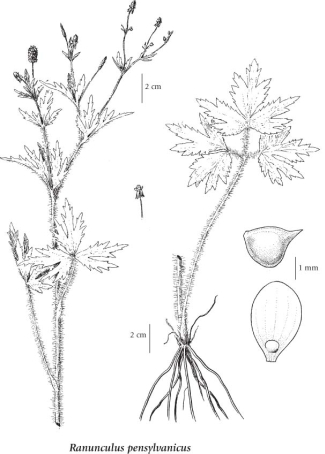Ranunculus pensylvanicus L. f.
Pennsylvania buttercup (bristly crowfoot)
Ranunculaceae (Buttercup family)
Introduction to Vascular Plants
Pennsylvania buttercup (bristly crowfoot)
Ranunculaceae (Buttercup family)
Introduction to Vascular Plants
Species Information click to expand contents
General:
Annual or short-lived perennial herb from a cluster of fibrous roots; stems single, erect, 30-60 (100) cm tall, hollow; plants stiff-hairy.
Leaves:
Basal, persistent, heart-shaped, 3-parted, 1.6-7 cm long, 3-9 cm wide, the leaflets usually deeply cleft, the ultimate segments narrowly elliptic, coarsely sharp-toothed, tips pointed, the leaf stalks to 15 cm long, the stalks of lateral leaflets 3-20 mm long; stem leaves alternate, 3 to 8, transitional to upper 3- to 5-lobed and toothed bracts.
Flowers:
Inflorescence of few-flowered, terminal cymes, the flower stalks to 6 cm long; receptacle long stiff-hairy; petals 5, distinct, yellow, 2-4 mm long, 1-2.5 mm wide, broadly egg-shaped, nectary on upper surface, the scale about 0.7 mm long, smooth; sepals 5, bent back about 1 mm above base, deciduous, 3-5 mm long, 1.5-2 mm wide, more or less long stiff-hairy; stamens 15-25; pistils 50-80.
Fruits:
Grouped in a cylindric head 9-12 mm long, 5-7 mm wide, the achenes elliptic to egg-shaped, 1.8-2.8 mm long, 1.6-2 mm wide, smooth, margins slightly keeled; beaks persistent, broadly lanceolate or triangular, 0.6-0.8 mm long, straight or nearly so.
Illustration click to expand contents

If more than one illustration is available for a species (e.g., separate illustrations were provided for two subspecies) then links to the separate images will be provided below. Note that individual subspecies or varietal illustrations are not always available.
Illustration Source: The Illustrated Flora of British Columbia
USDA Species Characteristics click to expand contents
Flower Colour:
Yellow
Blooming Period:
Mid Summer
Fruit/Seed characteristics:
Colour: Black
Present over the Summer
Source: The USDA
Ecology click to expand contents
Ecological Framework for Ranunculus pensylvanicus
The table below shows the species-specific information calculated from
original data (BEC database) provided by the BC Ministry of Forests and Range.
(Updated August, 2013)
The table below shows the species-specific information calculated from
original data (BEC database) provided by the BC Ministry of Forests and Range.
(Updated August, 2013)
| Site Information |
Value / Class |
||
|
Avg |
Min |
Max |
|
| Elevation
(metres) |
782 | 170 | 1740 |
| Slope
Gradient (%) |
2 | 0 | 5 |
|
Aspect (degrees) |
137 | 90 | 190 |
| Soil
Moisture Regime (SMR) [0 - very xeric; 4 - mesic; 8 - hydric] |
5 | 5 | 6 |
| Modal
Nutrient Regime
Class |
D | ||
| #
of field plots species was recorded in: |
4 | ||
| Modal
BEC Zone Class |
CWH | ||
|
All BEC Zones (# of stations/zone) species was recorded in |
CWH(2), ICH(1), SBPS(1) | ||
|
Source:
Klinkenberg 2013
|
|||
Habitat and Range click to expand contents
Wet to moist streambanks, ditches, thickets, meadows and forest edges in the lowland and montane zones; frequent S of 56degreeN east of the Coast-Cascade Mountains, rare westward; E to NF and S to NJ, NM, AZ, ID, MT and WA.